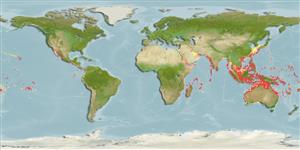>
Kurtiformes (Nurseryfishes, cardinalfishes.) >
Apogonidae (Cardinalfishes) > Apogoninae
Etymology: Siphamia: A Swazi word, siphama, for a fish.
More on author: Weber.
Environment: milieu / climate zone / depth range / distribution range
Ekologi
marina revassocierade; djupintervall 0 - 100 m (Ref. 90035), usually 1 - 18 m (Ref. 90102). Tropical
Indo-West Pacific: from the Red Sea south to Madagascar and east through the Maldives, Sri Lanka and India to the Andaman Sea Islands and Western Australia; north to Ryukyus; throughout the Indo-Malayan region to Vanuatu.
Size / Vikt / Age
Maturity: Lm ? range ? - ? cm
Max length : 7.0 cm TL hane/ej könsbestämd; (Ref. 89972)
Short description
Morfologi | Morfometri
Taggstrålar i ryggfenan (totalt): 8; Mjukstrålar i ryggfenan (totalt): 9; Taggstrålar i analfenan 2; Mjukstrålar i analfenan: 8. This species is distinguished by the following characters: D1 VII, D2 I,9; A II,8; pectoral fin rays 14-16; tubed lateral-line scales 20-24; median predorsal scales 4 (rarely 3 or 5); total gill rakers 2-4 + 8-10 = 11-14; developed gill rakers 1 + 7-9; gill rakers on ceratobranchial 7-8; body depth 2.3-2.7 in SL and body width 1.9-2.2 in the depth; eye diameter 2.6-3.5 in HL; first dorsal spine 2.4-4.6 in second spine; second dorsal spine 3.7-6.6, second dorsal fin spine 3.7-5.4, second anal spine 5.0-7.0, all in head length; pectoral-fin length 4.2-5.3 and pelvic-fin length 4.2-4.7 in SL; caudal peduncle length 1.5-2.1 in distance between pelvic spine insertion and anal-fin origin; preopercular edge with 23-35 serrations, the preopercular ridge smooth; scales mostly spinoid, but some cycloid scales on anterior part of body; vomer and palatines with 1-2 series of small teeth, but palatines sometimes toothless; tip of light organ on each side of tongue bound by membrane (Ref. 90035).
Found in coastal reefs and outer reef lagoons. This species forms small groups with long-spined urchins (Ref. 48635) (e.g. Diadema setosum in shallow sheltered waters, Ref. 1602); but was also found among the spines of Acanthaster planci (Ref. 90035). Feeds on zooplanktons and small invertebrates (Ref. 89972).
Distinct pairing during courtship and spawning (Ref. 205).
Gon, O. and G.R. Allen, 2012. Revision of the Indo-Pacific cardinalfish genus Siphamia (Perciformes: Apogonidae). Zootaxa 3294:1-84. (Ref. 90035)
IUCN Red List Status (Ref. 130435)
Threat to humans
Harmless
Human uses
Ytterligare information
Age/SizeTillväxtLength-weightLength-lengthLength-frequenciesMorfometriMorfologiLarverLarvdynamikRekryteringAbundansBRUVS
referenserVattenbrukVattenbruksprofilAvelslinjerGenetikElectrophoresesÄrftlighetSjukdomarBehandlingNutrientsMass conversion
MedarbetareBilderStamps, Coins Misc.LjudCiguateraHastighetSimsättGälytaOtolithsHjärnstorlekSyn
Verktyg
Special reports
Download XML
Internet-källor
Estimates based on models
Preferred temperature (Ref.
123201): 24.6 - 29.2, mean 28.3 °C (based on 4132 cells).
Phylogenetic diversity index (Ref.
82804): PD
50 = 0.5000 [Uniqueness, from 0.5 = low to 2.0 = high].
Bayesian length-weight: a=0.01479 (0.00690 - 0.03171), b=3.09 (2.91 - 3.27), in cm total length, based on LWR estimates for this (Sub)family-body shape (Ref.
93245).
Trofisk nivå (Ref.
69278): 3.5 ±0.50 se; based on food items.
Resiliens (Ref.
120179): Hög, lägsta populationsfördubblingstid mindre än 15 månader (Preliminary K or Fecundity.).
Fishing Vulnerability (Ref.
59153): Low vulnerability (10 of 100).
Nutrients (Ref.
124155): Calcium = 184 [87, 344] mg/100g; Iron = 1.21 [0.66, 2.28] mg/100g; Protein = 18.4 [17.1, 19.7] %; Omega3 = 0.146 [0.069, 0.312] g/100g; Selenium = 47.6 [19.5, 104.8] μg/100g; VitaminA = 50.4 [12.9, 206.5] μg/100g; Zinc = 2.15 [1.32, 3.34] mg/100g (wet weight);
